Real Numbers
Question 1.
Express each number as a product of its prime factors:
(i) 140
(ii) 156
(iii) 3825
(iv) 5005
(v) 7429
Solution:
(i) We use the division method as shown below:
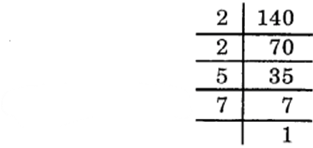
∴ 140 = 2 × 2 × 5 × 7 = 22 × 5 × 7
(ii) We use the division method as shown below:
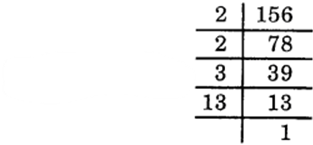
∴ 156 = 2 × 2 × 3 × 13 = 22 × 3 × 13
(iii) We use the division method as shown below:

∴ 3825 = 3 × 3 × 5 × 5 × 17
= 32 × 52 × 17
(iv) We use the division method as shown below:

∴ 5005 = 5 × 7 × 11 × 13
(v) We use the division method as shown below:
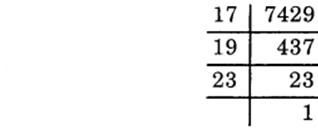
∴ 7429 = 17 × 19 × 23
Question 2.
Find the LCM and HCF of the following pairs of integers and verify that LCM × HCF = product of the two numbers.
(i) 26 and 91
(ii) 510 and 92
(iii) 336 and 54
Solution:
(i) 26 and 91

∴ LCM of 26 and 91 = 2 × 7 × 13 = 182
and HCF of 26 and 91 = 13
Now, 182 × 13 = 2366 and 26 × 91 = 2366
Thus, 182 × 13 = 26 × 91
Hence verified.
(ii) 510 and 92
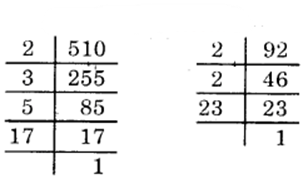
510 = 2 × 3 × 5 × 17 and 92 = 2 × 2 × 23
∴ LCM of 510 and 92 = 2 × 2 × 3 × 5 × 17 × 23
= 23460
and HCF of 510 and 92 = 2
Now, 23460 × 2 = 46920 and 510 × 92 = 46920
Thus, 23460 × 2 = 510 × 92
Hence verified.
(iii) 336 and 54
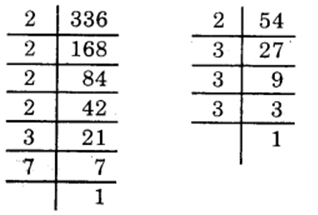
336 = 2 × 2 × 2 × 2 × 3 × 7
and 54 = 2 × 3 × 3 × 3
∴ LCM of 336 and 54 = 2 × 2 × 2 × 2 × 3 × 3 × 3 × 7
= 3024
and HCF of 336 and 54 = 2 × 3 = 6
Now, 3024 × 6 = 18144 and 336 × 54 = 18144
Thus, 3024 × 6 = 336 × 54
Hence verified.
Question 3.
Find the LCM and HCF of the following integers by applying the prime factorisation method:
(i) 12, 15 and 21
(ii) 17, 23 and 29
(iii) 8, 9 and 25
Solution:
(i) First we write the prime factorisation of each of the given numbers.
12 = 2 × 2 × 3 = 22 × 3, 15 = 3 × 5 and 21 = 3 × 7
∴ LCM = 22 × 3 × 5 × 7 = 420
and HCF = 3
(ii) First we write the prime factorisation of each of the given numbers.
17 = 1 × 17, 1 × 23 and 1 × 29
[Note that here each of the numbers 17, 23 and 29 is a prime]
∴ LCM = 17 × 23 × 29
= 11339
and HCF = 1
[Note that in 17, 23 and 29, there is no common prime factor]
(iii) First we write the prime factorisation of each of the given numbers.
8 = 2 × 2 × 2 = 23, 9 = 3 × 3 = 32, 25 = 5 × 5 = 52
∴ LCM = 23 × 32 × 52 = 8 × 9 × 25 = 1800
and HCF = 1
Question 4.
Given that IICF (306, 657) = 9, find LCM (306, 657).
Solution:
We know that the product of the HCF and the LCM of two numbers is equal to the product of the given numbers.
∴ HCF (306, 657) × LCM (306, 657) = 306 × 657
So, 9 × LCM (306, 657) = 306 × 657
or LCM (306, 657) = (306×657)/9
= 22338
Question 5.
Check whether 6n can end with the digit 0 for any natural number n.
Solution:
If the number 6n, for any n, ends with the digit 0, then it is divisible by 5. That is, the prime factorisation of 6n contains the prime 5. This is not possible as the only primes in the factorisation of 6n are 2 and 3 and the uniqueness of the Funtlaniental Theorem of Arithmetic guarantees that there are no other primes in the factorisation of 6n. So, there is no natural number n for which 6n ends with the digit 0.
Question 6.
Explain why 7 × 11 × 13 + 13 and 7 × 6 × 5 × 4 × 3 × 2 × 1 + 5 are composite numbers.
Solution:
Now, 7 × 11 × 13 + 13 = 13 × (7 × 11 × 1 + 1)
= 13 × (77 + 1) = 13 × 78
Hence, it is a composite number.
Again, 7 × 6 × 5 × 4 × 3 × 1 × 1 + 5
= 5 × (7 × 6 × 4 × 3 × 1 × 1 + 1)
So, it is a composite number.
Question 7.
There is a circular path around a sports field. Sonia takes 18 minutes to drive one round of the field, while Ravi takes 12 minutes for the same. Suppose they both start at the same point and at the same time, and go in the same direction. After how many minutes will they again at the starting point?
Solution:
They will be again at the starting point after common multiples of 18 and 12 minutes. To find the LCM of 18 and 12, we have:

LCM of 18 and 12 = 2 × 2 × 3 × 3 = 36
So, Sonia and Ravi will meet again at the starting point after 36 minutes.
